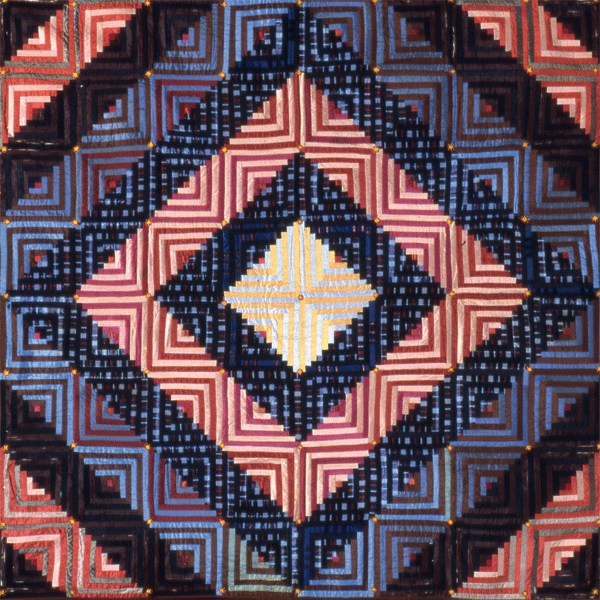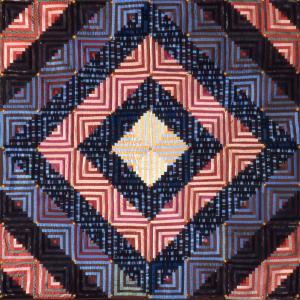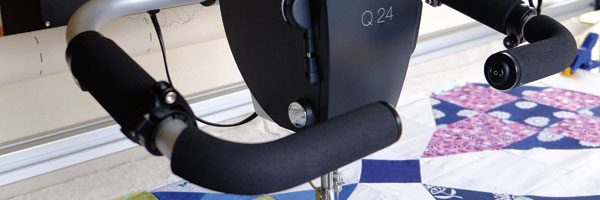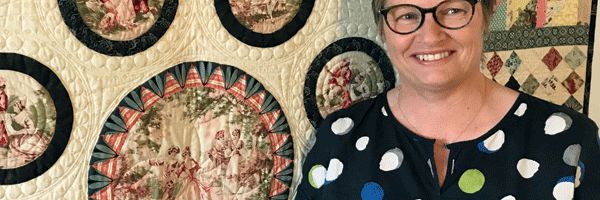
In the Seams: Log Cabin Barn Raising

This quilt is a Log Cabin Barn Raising pattern made with silk and cotton fabrics. It is machine-pieced with strip/string piecing. It also features embroidery and burgundy and gold-embroidered ships wheel in the corner of each block. The quilt has been machine-quilted.
The earliest known versions of this pattern appear in Great Britain on the Isle of Man. There they are called ‘rooftop’ or ‘roof tile’ quilts, possibly for their emulation of roofs made of the local slate. Manx log cabin-style quilts are foundation-pieced and incorporate a folded edge to the strips. This created a multilayer fabric that did not need additional batting or quilting stitches, allowing fast and easy manufacture of a warm bedcover, especially when made of wools and tweeds. Measurements were taken from the quilt maker’s own hand, not rulers, incorporating an additional level of personal creative expression.
Women’s magazines and needlework textbooks of the mid- to late-19th century on both sides of the Atlantic refer to the pattern as ‘Canadian Patchwork’ or ‘Log House pattern’. This suggests the design first crossed the Atlantic Ocean with English immigrants into Canada, and then infiltrated the United States by unverifiable means.
The pattern became so popular in the 1890s that state fairs created a separate category in their quilt competitions for what were by then called Log Cabin quilts. Versions appear in either wool or silk or combinations of both. Antique log cabin quilts made of cotton are less common. Many quilts still utilised the folded strips on foundation piecing method, but many were also constructed with the ‘logs’ flat and pieced directly to each other like other patchwork. Both methods continue to be used today.
In the late-19th and early-20th century, much symbolism was imagined concerning the colour of the centre square. If red it was described as depicting the hearth fire, if yellow a lighted window; but antique quilts have centres of all colours. Beware of anyone who tries to convince you that a black centre square was either a sign of mourning or had an association with the Underground Railroad. No documentation supports these views.
This quilt is made of solid and print silks in the flat construction method. The corners of the blocks have an embroidered ‘ship’s wheel’ detail. It is inscribed with the initials JAH and the date 1882. Donor information and genealogy research identify the maker as Julia Ann Hosmer.
Born Julia Ann Eastman in 1812 in Brunswick, Maine, she was the fourth child of 13 born to Robert Eastman (1783-1869) and Sara-Hannah Lee (1786-1878). She married three times. The United States has a Federal census taken every 10 years, and for three censuses in a row (1850, 1860 and 1870) she had a different husband and new last name each time. Her first husband (Jonathan Palmer c 1814-1856) died when she was just 34. Her second husband (Richard P. Dunlap 1789-1863) was considerably older than she was and had buried two previous wives. A decent interval after he also died, she married her third husband, William Henry Hosmer (1814-1902), who had also been previously married and eventually outlived her. Despite her many spouses, she had no children of her own but acted as step-mother to her husbands’ progeny. Her quilts descended through the family of one of her younger brothers until donated to the DAR.
While much needlework is historically done by young women, Julia Ann made this quilt and another in the DAR collection (DAR 85.70) while in her late 60s. She was following contemporary fashion with both her quilts by making a log cabin pattern and an equally popular Crazy quilt. She and William Hosmer were living in Concord, New Hampshire, at the time the quilt was made. She lived until April 29, 1899, to 86 years old, with a personal history as colourful and complex as her quilts.
Virginia Vis is a volunteer curatorial assistant, working with Alden O’Brien, curator of textiles at the Daughters of the American Revolution Museum in America. More information about this quilt and others in the DAR collection can be viewed on the Quilt Index: www.quiltindex.org


